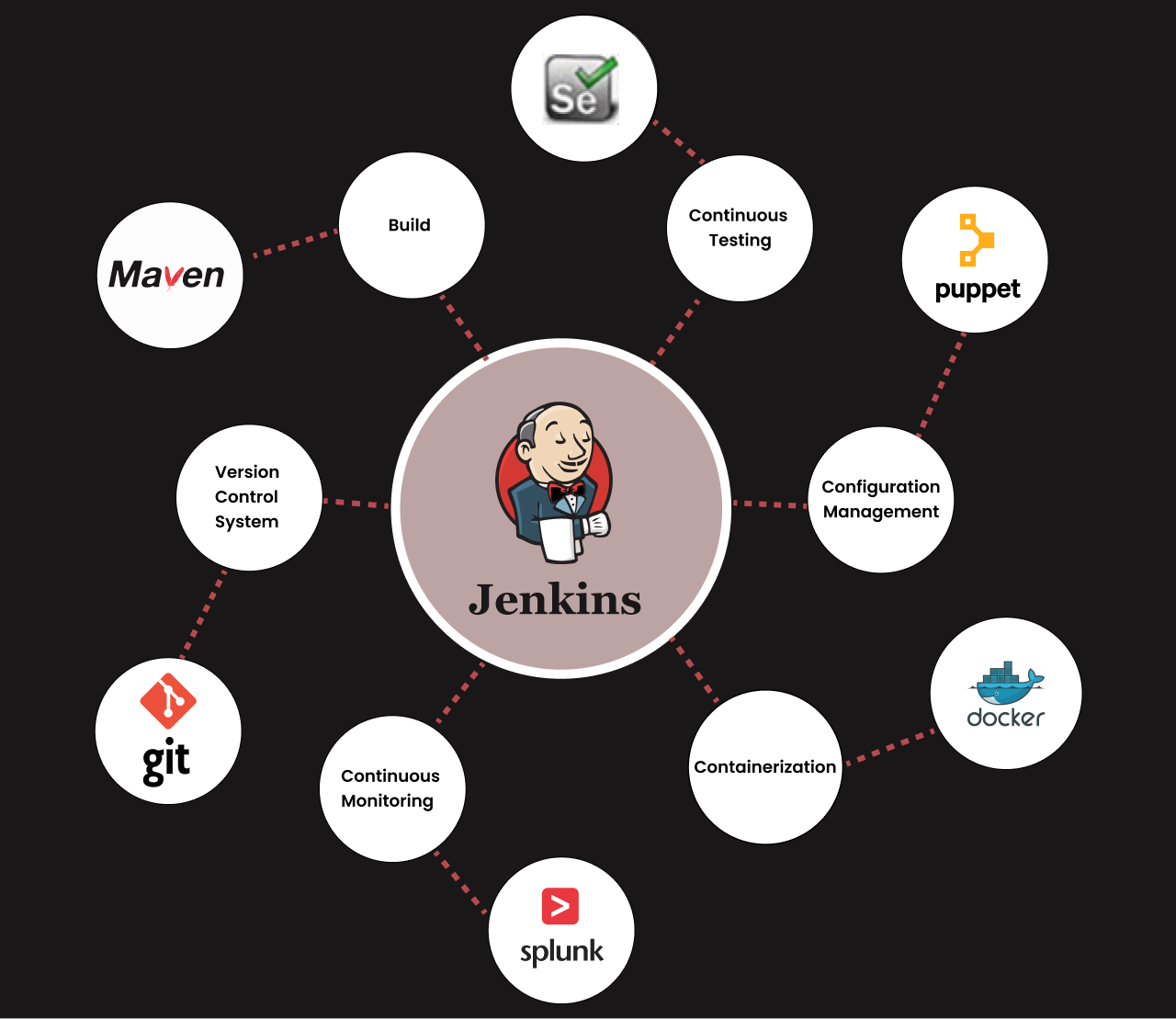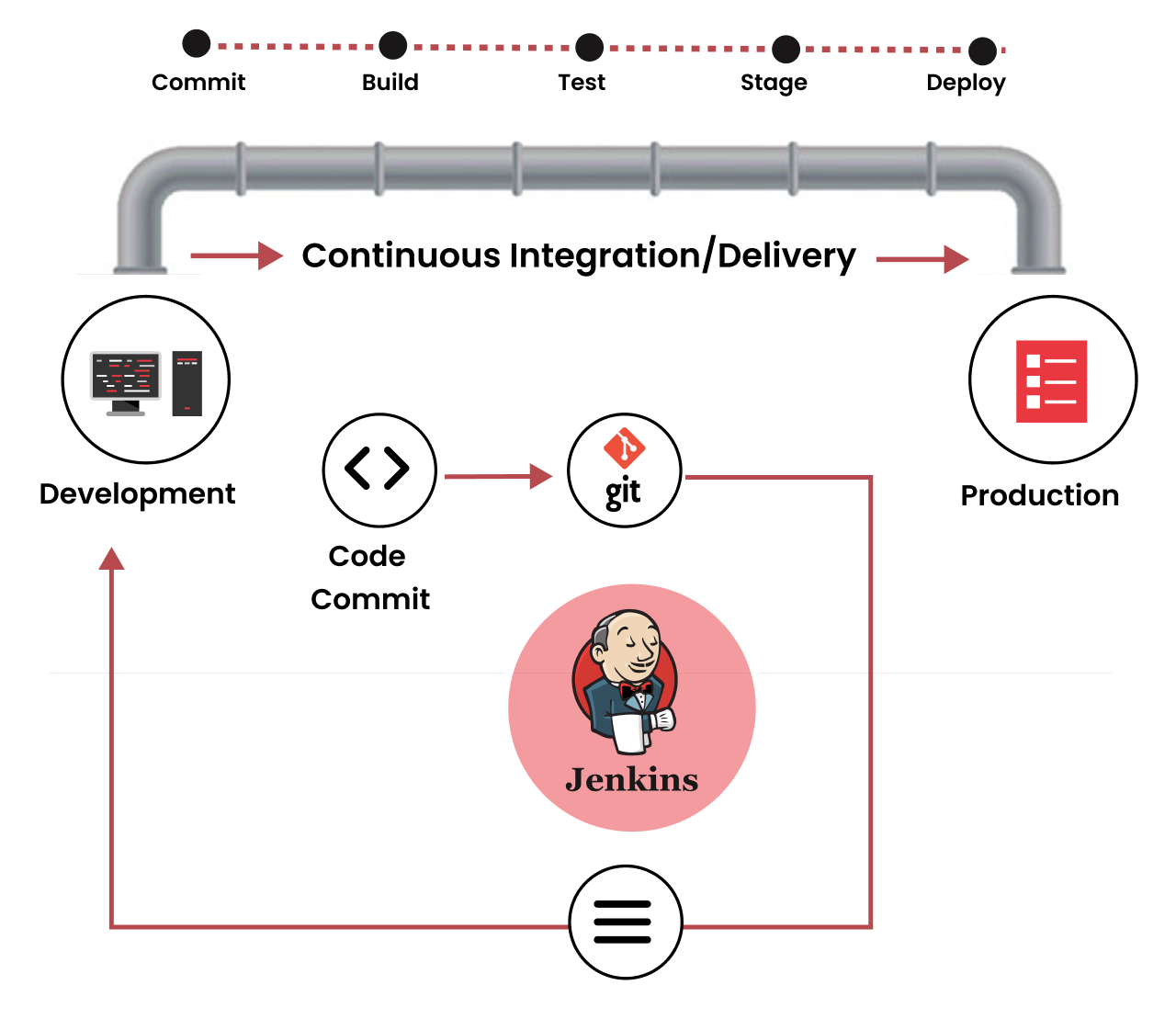Software development is a time-consuming process. From building, designing, and testing, to deployment, every stage in SDLC requires precision, time, and effort. Luckily, there is a way to automate these stages with Jenkins in DevOps.
It is an open-source automation tool that has gradually become a leading choice for DevOps teams seeking robust automation capabilities.
Furthermore, Jenkins is a flexible and extensible platform that supports continuous integration, continuous delivery, and continuous deployment. Thus, enhancing the agility and speed of the software development process. This is the main reason for its popularity.
But wait, there’s more about DevOps Jenkins. Unfold more about Jenkins in our blog and find out what is the role of Jenkins in DevOps and what makes it invaluable.
What is Jenkins in DevOps?

Jenkins is a Java-based automation server that orchestrates and automates the entire software delivery pipeline. Its rich set of features, plugins, and integrations, make it a highly customizable and adaptable platform for different environments. The popular DevOps automation tool is renowned for its extensive community support, vast plugin ecosystem, and ease of integration with various development and deployment tools.
Hope you have understood what Jenkins in Devops is, let’s explore the features that make it the preferred Devops automation tool.
Key Features of Jenkins:
Continuous Integration: Jenkins enables seamless integration of code changes, automatically triggering builds and tests whenever new code is committed to the version control system. This ensures early detection of issues and provides rapid feedback to developers.
Pipeline as Code: Jenkins offers a powerful pipeline-as-code feature, allowing teams to define their software delivery pipelines as code. This approach provides version control, scalability, and reproducibility, making pipeline management more manageable and enabling teams to adopt best practices such as code reviews and automated testing.
Extensibility through Plugins: Jenkins boasts a vast plugin ecosystem, offering integrations with various tools, technologies, and cloud platforms. These plugins expand Jenkins’ capabilities, enabling teams to customize their automation workflows to meet specific requirements.
Distributed Builds: Jenkins supports distributed builds, allowing teams to distribute the building workload across multiple machines. This feature improves build performance, reduces build times, and enhances overall scalability.
Easy Configuration and Monitoring: DevOps Jenkins provides a user-friendly web-based interface for configuration and monitoring. Administrators can easily set up jobs, manage credentials, and monitor build statuses and logs, simplifying the management of automation processes.
Easy Installation: When installing this DevOps automation tool, there is no need to worry about the device’s operating system. Jenkins is compatible with most of the standard operating systems such as Windows, macOS, Unix, and Linux. However, even if you face while installing, the Jenkins community is always there to help.
Learn how it works and what is a pipeline in Jenkins in the next chapter of our Jenkins guide.
How Does Jenkins Work?
Jenkins follows a master-agent architecture, where the master serves as the central control system, and agents (also known as slaves) perform the actual execution of jobs. The general workflow of Jenkins includes the following steps:
- Configuration: Administrators set up and configure Jenkins by installing it on a server and defining global configurations such as security settings, plugin installations, and system preferences.
- Job Creation: Users create jobs within Jenkins, specifying the tasks to be executed, such as source code management, build steps, tests, and deployment instructions.
- Triggers: Jobs can be triggered in various ways, including schedule-based triggers, source code repository hooks, or manually through the Jenkins interface.
- Execution: When a job is triggered, the master node assigns the job to an available agent based on predefined labels, ensuring workload distribution and scalability.
- Build and Testing: The agent retrieves the source code, performs the defined build steps, executes tests, and generates build artifacts.
- Deployment and Reporting: If the build and tests are successful, Jenkins can automatically deploy the software to the desired environment. Additionally, Jenkins provides comprehensive reporting and logging features to monitor the status and results of each job.
Jenkins Pipeline Guide

Jenkins Pipeline is a powerful feature that allows teams to define their entire software delivery pipeline as code. It provides a structured, programmable way to model, visualize, and execute complex workflows.
Key aspects of Jenkins Pipeline include:
Declarative Syntax: Jenkins supports both Declarative and Scripted Pipeline syntax. Declarative Pipeline offers a more structured and opinionated approach, while Scripted Pipeline allows more flexibility and control.
Stages and Steps: Pipelines consist of stages, representing different phases of the software delivery process, such as build, test, and deploy. Each stage contains one or more steps, which define specific actions to be performed.
Parallel Execution: Jenkins Pipeline supports parallel execution, allowing multiple stages or steps to run concurrently, thereby optimizing the overall pipeline execution time.
Version Control Integration: Pipeline definitions can be stored in version control repositories, providing traceability, collaboration, and the ability to manage pipeline changes over time.
Pipeline Visualization: Jenkins provides a graphical visualization of Pipeline executions, enabling teams to monitor and analyze the progress of each stage and step.
Security in Jenkins
Security is a critical aspect of any automation tool, especially when it comes to managing software delivery pipelines and handling sensitive data. DevOps Jenkins provides several features and best practices to ensure the security of your automation environment. Let’s explore some key considerations for implementing security in Jenkins:
Authentication and Authorization:
User Authentication: Jenkins supports various authentication mechanisms, such as username/password, LDAP, and integration with external identity providers like OAuth or SAML. It is crucial to enforce strong password policies and encourage the use of multi-factor authentication to protect user accounts.
Authorization: Jenkins offers role-based access control (RBAC) to define user roles and assign specific permissions. Limiting access to sensitive features and data ensures that only authorized users can perform critical actions.
Plugin and Configuration Security:
Plugin Management: Regularly review and update Jenkins plugins to ensure they are up to date with the latest security patches. Remove any unnecessary or unused plugins to reduce potential vulnerabilities.
Configuration Review: Regularly review Jenkins configuration files to ensure that security settings, such as CSRF protection, agent protocols, and agent-to-master communication, are properly configured.
Securing Jenkins Master and Agents:
Network Segmentation: Isolate the Jenkins master server and agents from other critical systems by placing them on separate network segments or virtual private networks (VPNs).
Agent Security: Control agent access by using firewall rules, security groups, or network access control lists (ACLs) to restrict communication to authorized systems only.
Secure Communication: Ensure that communication between the Jenkins master and agents is encrypted using SSL/TLS protocols. This prevents eavesdropping and unauthorized access to sensitive data.
Job and Pipeline Security:
Code Review: Implement code review processes for pipeline scripts and job configurations to identify and address potential security risks in the automation code.
Secrets Management: Avoid hard-coding sensitive information, such as passwords or API keys, in job configurations or pipeline scripts. Utilize Jenkins credential management features or external secret management solutions to securely store and retrieve sensitive data.
Job Isolation: Isolate jobs and pipelines to limit access and execution permissions. This prevents unauthorized users from manipulating or interfering with critical automation processes.
Monitoring and Auditing:
Logging and Monitoring: Enable detailed logging and monitoring in Jenkins to capture and analyze security-related events, such as failed login attempts or suspicious activities. Regularly review logs to detect any potential security incidents.
Audit Trails: Enable audit trail plugins in Jenkins to maintain a record of important activities and changes performed in the system. This facilitates post-incident investigations and compliance requirements.
Takeaway
Revolutionize your software delivery pipeline by incorporating Jenkins in DevOps automation strategy. Its features and capabilities promise to empower your DevOps teams to achieve faster feedback, streamline development processes, and ensure the delivery of high-quality software.



